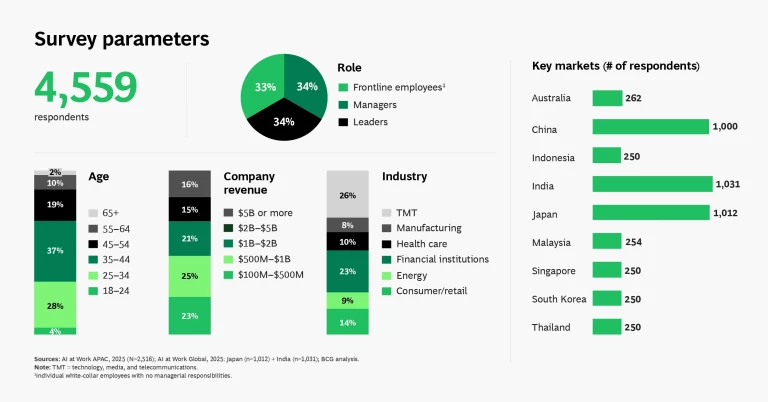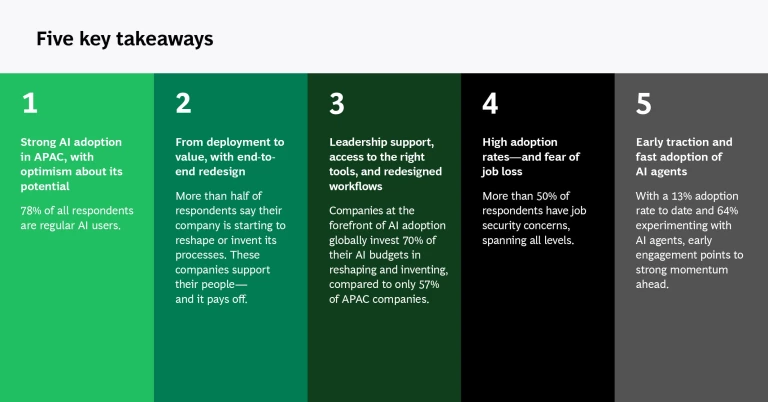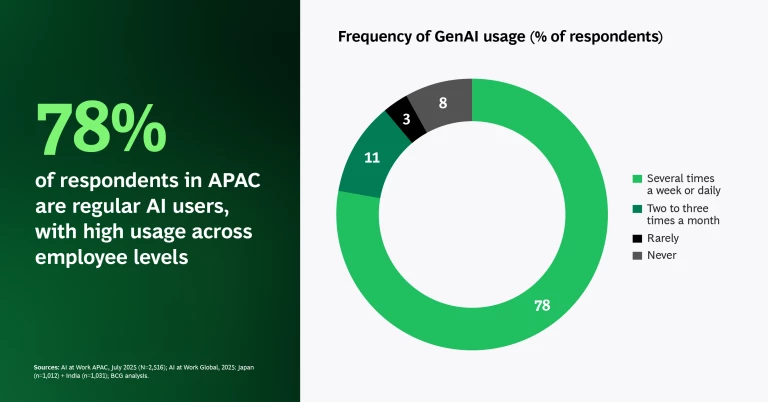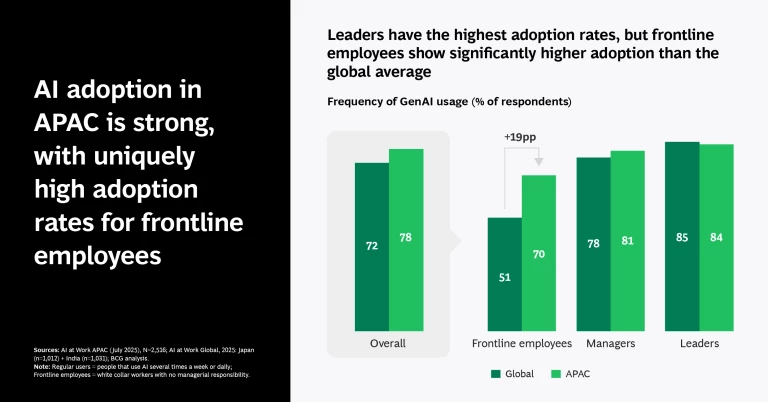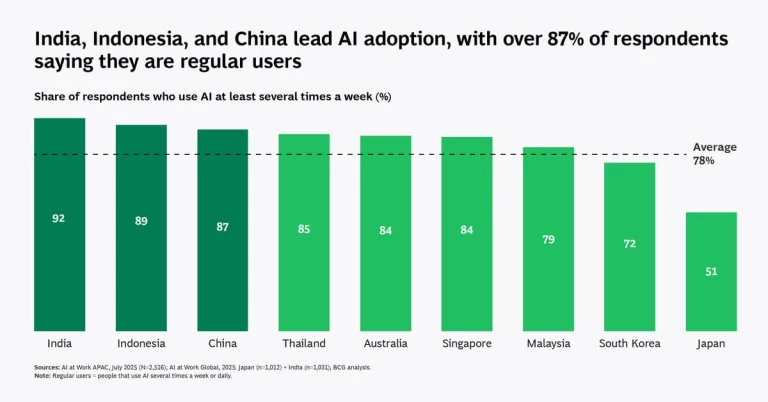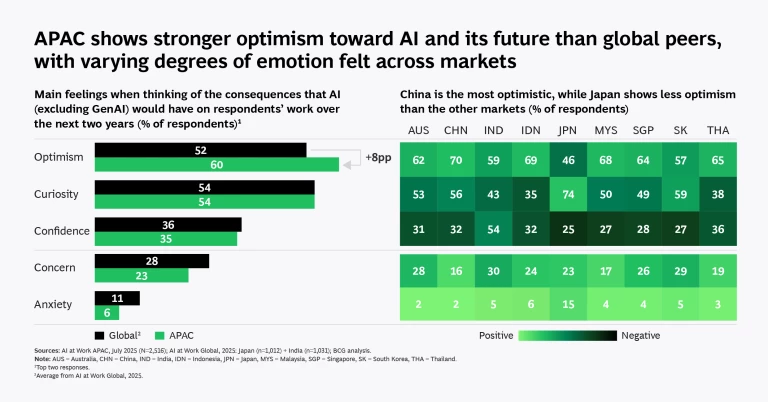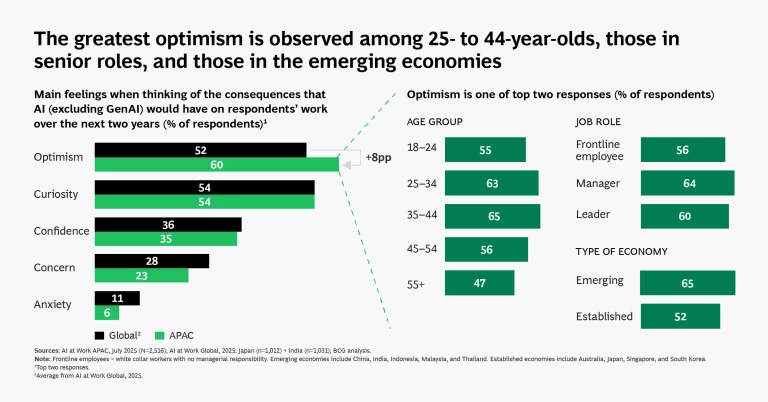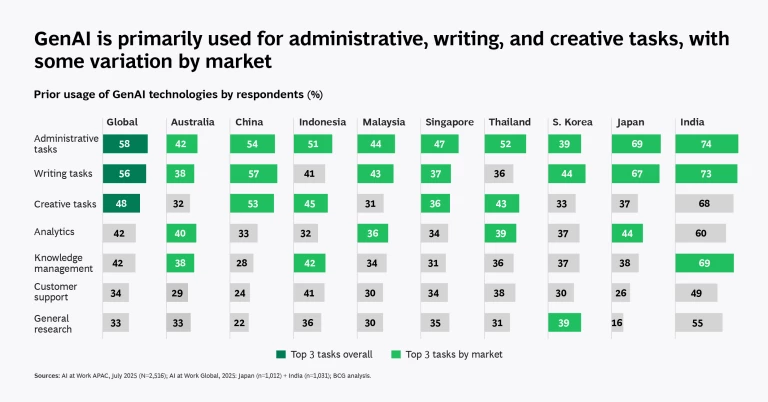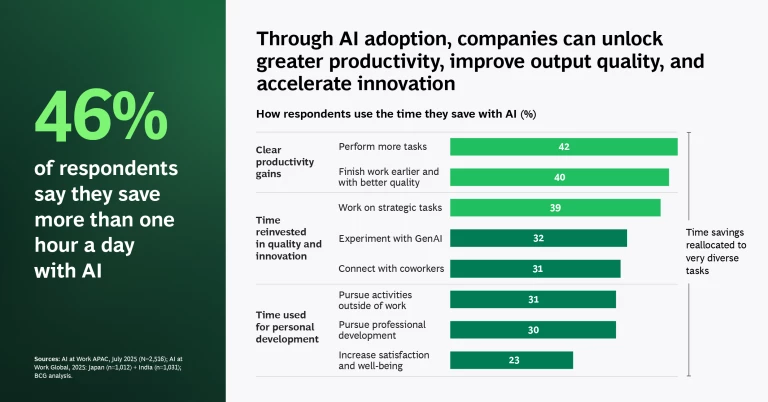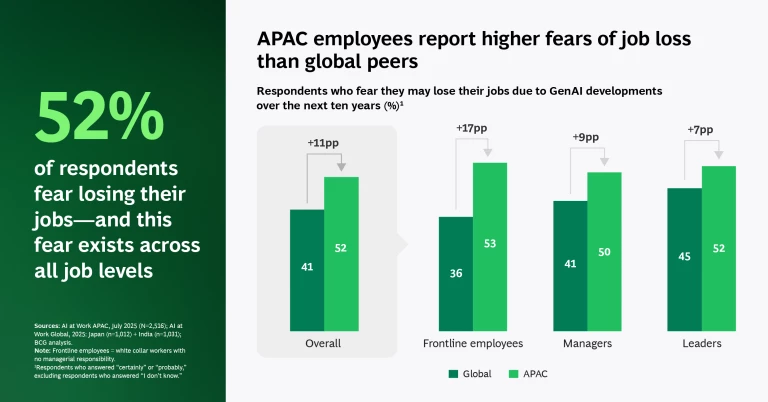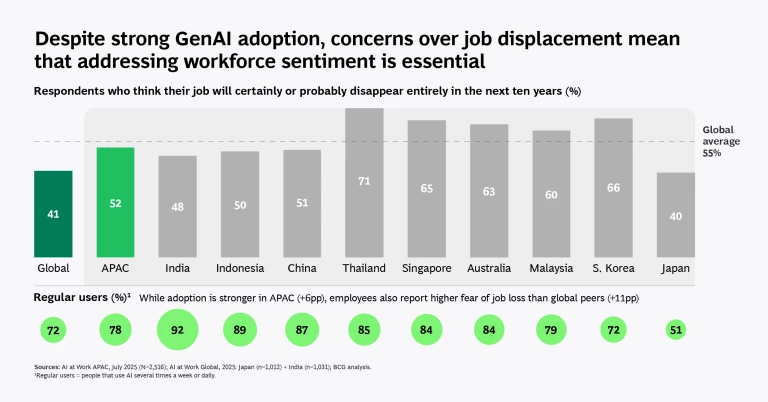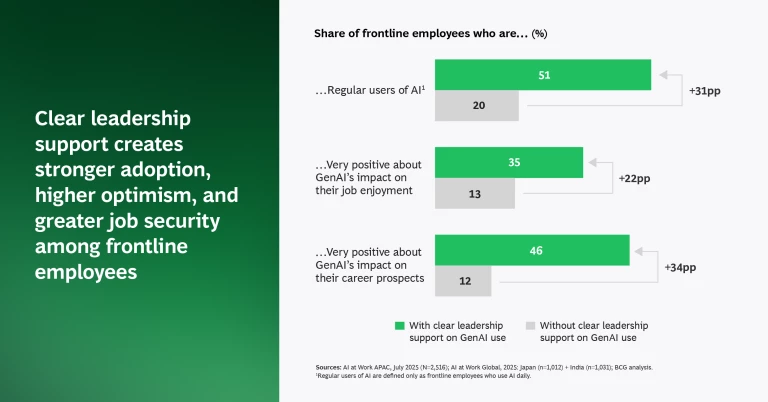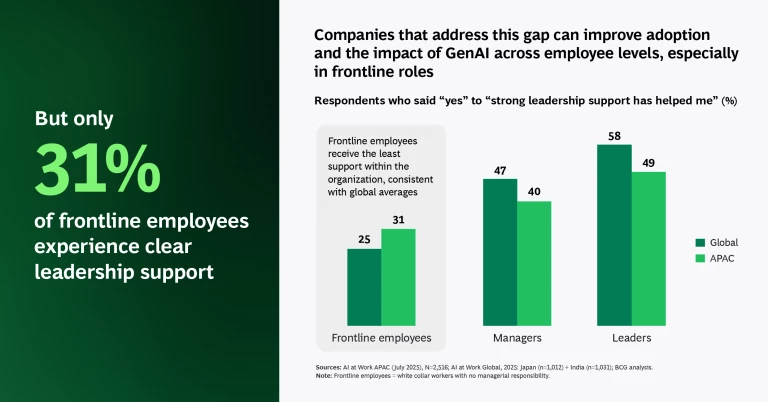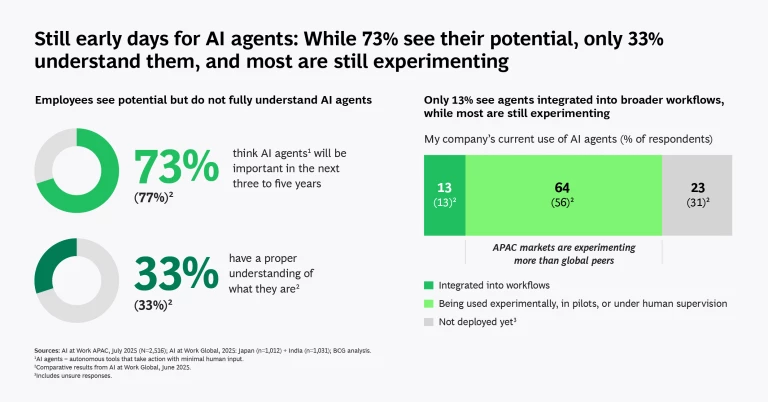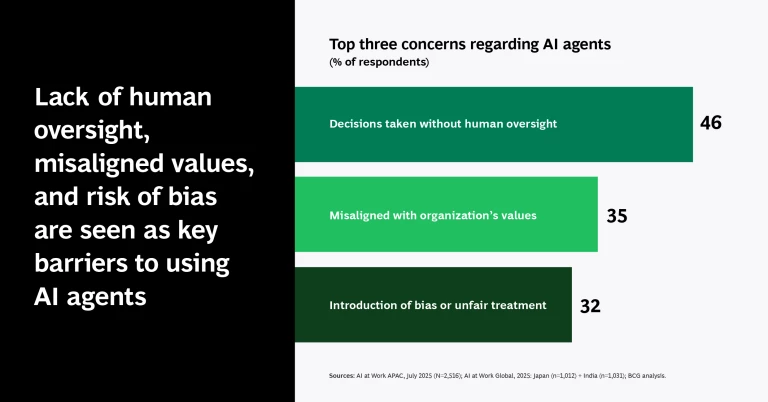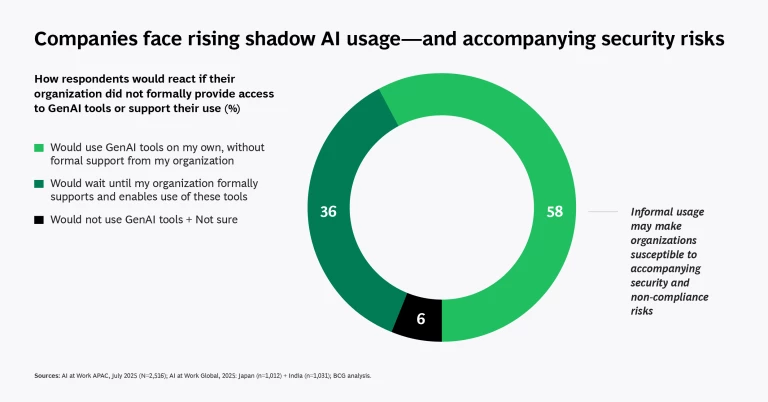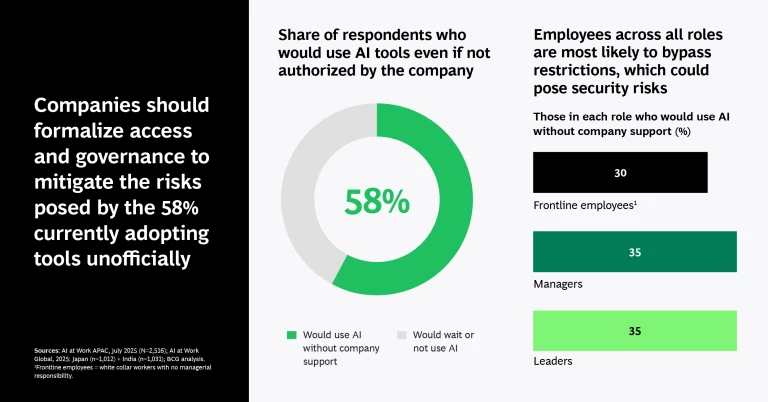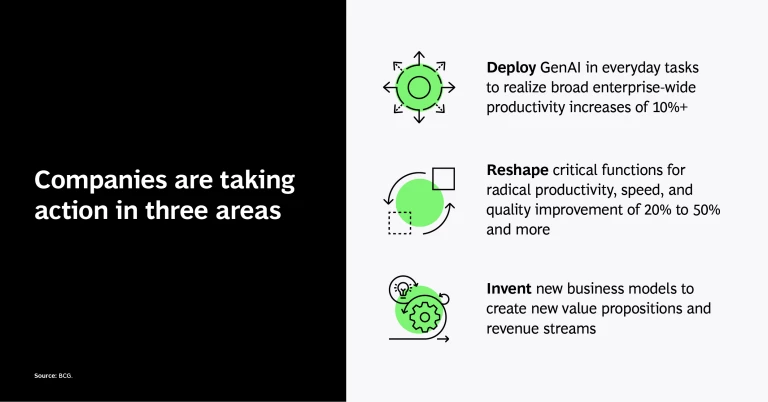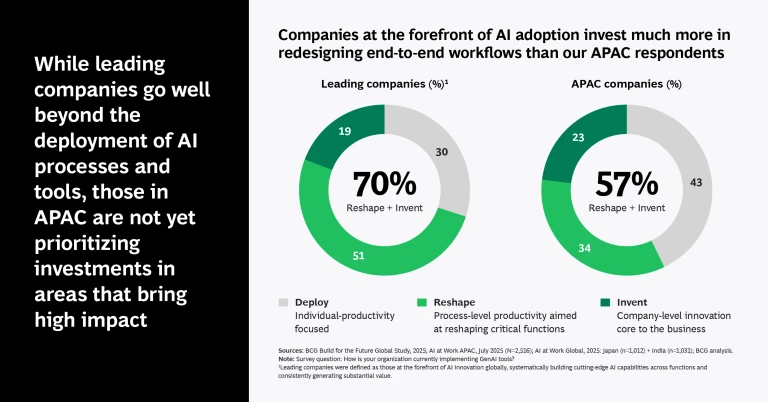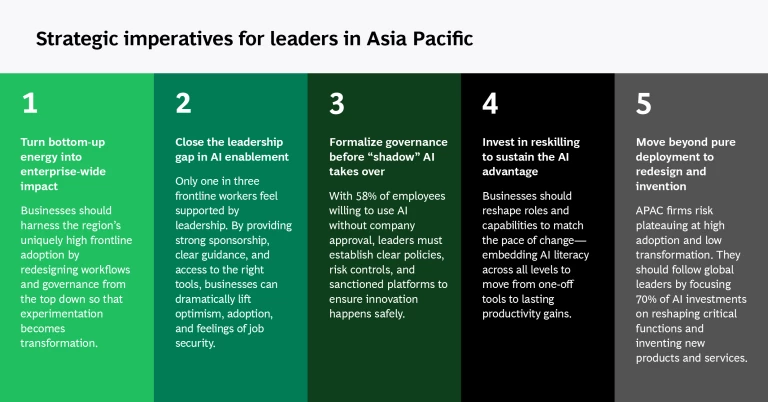As businesses across the globe adopt and experiment with AI, Asia Pacific has pulled ahead. Seventy-eight percent of overall respondents in a recent APAC survey say they use AI at work at least weekly, compared to 72% worldwide. And APAC’s frontline employees are uniquely active: While only 51% of global frontline workers (white collar workers with no managerial responsibility) use AI regularly, the rate jumps to 70% in APAC, signaling a bottom-up cultural energy.
The region’s higher AI usage is accompanied by greater enthusiasm, with 60% of APAC respondents feeling optimistic about AI’s potential, compared to 52% globally. One reason may be AI’s time-saving help: close to 50% of those surveyed already save more than an hour a day by using generative AI (GenAI) at work—whether or not their employer formally supports and enables use of the technology. And these employees are putting their new free time toward getting more work done (42%), finishing work earlier (40%), and working on strategic tasks (39%), among other pursuits. Some are even using their time savings to further experiment with AI (32%).
Stay ahead with BCG insights on artificial intelligence
There is an inherent tension to AI usage, however, as greater adoption leads to greater fear of future job loss due to AI. Even as employees in APAC adopt AI at a faster pace than those in other regions, more employees fear losing their jobs, with 52% of respondents expressing that concern, compared to 41% globally. It seems that the more employees use AI, the more powerful—and threatening—it feels.
An additional source of tension arises with high employee adoption rates: Only 57% of APAC respondents say their organizations are transforming workflows to accommodate the shift, compared to 70% of global businesses at the forefront of AI adoption. Without this transformation, businesses risk stunting their productivity growth. In contrast, companies that leverage the right tools and invest in areas where AI will have the highest impact can deploy AI in everyday tasks, reshape roles and functions, and invent new products and services, building long-term competitive advantage.
These findings are revealed in BCG’s July 2025 AI at Work survey, in which we queried over 4,500 employees across nine APAC countries in a range of industries about AI in the workplace, and in our global AI at Work survey conducted earlier this year. The results and our methodology are detailed in the accompanying slideshow.
Optimism—and Fear
While adoption of AI in the region is high, it varies by country—as do feelings about its potential impact. Emerging APAC economies such as India, Indonesia, and China lead the way, reflecting a young, ambitious workforce eager to embrace AI as a growth enabler and mobile-first workers leapfrogging managers in everyday AI use. These economies also show the highest optimism about AI, with 70% of China’s, 69% of Indonesia’s, and 68% of Malaysia’s respondents naming optimism as one of their top two feelings when thinking about the consequences of AI (excluding GenAI) over the coming two years.
In contrast, Japan stands out among APAC countries for its relatively low adoption rate, at 51%, and for a similar lack of positivity about AI, with just 46% of respondents expressing optimism (although 74% express curiosity about it). This high awareness and low confidence may well highlight the country’s cautious approach to disruption.
Even as adoption and optimism rise, however, so do job fears. As with optimism levels, rates of job concern vary across the region, reflecting Asia’s diversity—a disparity that foreshadows how the future of work will unfold differently around the world. Possibly as a result of the country’s relatively low adoption rate, only 40% of employees in Japan express concern. Meanwhile, Thailand, South Korea, and Singapore lead in AI-related job fears—even though not all are adoption leaders. And in India, which leads the region in adoption at 92% of employees, only 48% express concern over job displacement.
These job fears manifest across roles in APAC, with approximately 50% of business leaders, managers, and frontline employees expressing concern. However, frontline employees in APAC are unique in being more fearful of losing their jobs than their global peers, at 53%, versus just 36% worldwide. This frontline differential could well be a result of their unusually high adoption rate.
Experimentation—and Lack of Understanding
While GenAI dominates today’s AI usage, 73% of employees across APAC believe that independent AI agents—which can act with minimal human involvement—will be important in the next three to five years, and 77% say their businesses are already deploying or experimenting with them. But just 33% say they have a proper understanding of these agents, indicating that enthusiasm is outweighing comprehension. A governance and education gap therefore looms large, with key concerns about agentic AI including a lack of human oversight and the risk of misaligned values or bias.
High Adoption—and Ungoverned Usage
Much of AI adoption in APAC is taking place through individual “shadow,” or informal, AI usage, possibly indicating impatience with hierarchy. In fact, 58% of APAC employees say they would use AI tools even if their company did not formally provide them. This statement holds true across all levels, from frontline to the leadership.
Such ungoverned adoption poses security and non-compliance risks. Although AI is making work more efficient for many, the benefits risk being diluted without appropriate leadership direction.
In addition, even as so many employees are willing to use GenAI without company approval or governance—and with a 78% adoption level for the region—just 57% of respondents say their company is redesigning its workflows to accommodate the shift. Yet without reshaping and inventing the business, companies cannot achieve their full productivity potential.
Driving Transformation
We find a clear correlation between leadership support and employees’ feelings about AI’s potential impact on their job enjoyment and career prospects. This is true across roles, although frontline employees generally receive the least AI-related support today, both in APAC and globally. If they wish to boost adoption, raise optimism, and create a feeling of job security among their employees, companies should address their employees’ fears directly, establishing a clear AI narrative. And they should formalize both governance of and employee access to AI, avoiding the risks introduced by informal usage.
The Potential for Change
As they continue to lead the world in AI adoption and innovation, businesses in APAC should respond to their employees’ growing acceptance of AI and the innovation promised by AI agents, redesigning their workflows to accommodate the transition. And CEOs should drive the change both from the top down—through such approaches as reskilling at scale, continuously evaluating and upgrading AI tools, formalizing governance, and setting a clear AI vision—and from the bottom up, empowering digitally native frontline workers while closing skills gaps for middle managers. In this way, they can begin to channel AI adoption into lasting business impact, transforming their companies and workforces across the region.
The authors would like to acknowledge the many contributors to the research, writing, and production of this report, including Lilian Cheong and Mayank Kalia (CCI Vantage team) and Melissa Lou and Filipa Ivanova (BCGX).


